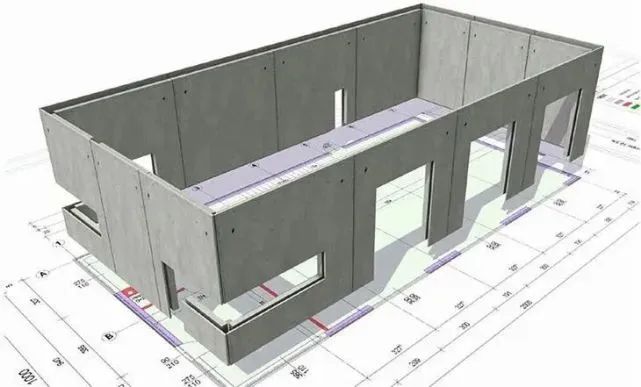Understand the differences between green buildings, passive buildings, precast buildings and low-energy buildings
Under the green building system, the state is also guiding and improving the energy consumption of buildings, so there are relevant standards for ultra-low energy consumption buildings, near zero energy consumption buildings and zero energy consumption buildings.

Its technical route is to reduce the building heating demand to less than 15kwh (㎡.A) by greatly improving the thermal performance and air tightness of the enclosure structure and using the high-efficiency fresh air heat recovery technology, so that the building can get rid of the traditional central heating system# Ultra low energy consumption building – a building that can adapt to the climatic characteristics and natural conditions at the level of active and passive technologies without the help of renewable energy, greatly reduce the heating and cooling demand of buildings through passive technical means, improve the efficiency of energy equipment and systems, and provide a comfortable indoor environment with less energy consumption.
At present, the one star standard has become a mandatory requirement for new buildings in many cities.
As an important way to reduce carbon emissions and alleviate the energy crisis, green building has naturally been vigorously promoted by the country# Green building green building refers to a building that can save resources to the greatest extent within the whole life cycle of the building, including energy, land, water and materials, protect the environment and reduce pollution, provide people with healthy, comfortable and efficient use space, and coexist harmoniously with nature.
With the rapid development of the real estate industry in the past decade, building energy consumption has become the major part of social energy consumption in China.
The difficulty of their implementation is roughly as follows: zero energy consumption building > near zero energy consumption building > ultra-low energy consumption building \, It is a building that can greatly improve the efficiency of energy equipment and system, make full use of the building body and the surrounding or purchased renewable energy, and make the annual energy supply of renewable energy greater than or equal to the total energy consumption of the building.
The building energy consumption level shall be reduced by more than 50% compared with relevant national and industrial standards (design standard for energy efficiency of public buildings gb-50189-2015, design standard for energy efficiency of residential buildings in severe cold and cold regions jgj26-2018, design standard for energy efficiency of residential buildings in hot summer and cold winter regions jgj134-2016, and design standard for energy efficiency of residential buildings in hot summer and warm winter regions jgj75-2012).

Therefore, these three terms actually belong to the same technical system, or the three stages of a building on the road of energy conservation.
The passive house of Hebei Construction Technology Research and development center, the first public building in China built with German passive house technology, is not clearly defined.
Under the current standards, nearly zero energy consumption buildings need to meet the two binding indicators of energy consumption and air tightness.

According to the maintenance structure, sound insulation performance and other indicators of buildings, green buildings can be divided into three levels: one star, two star and three star.
In the near zero energy consumption building technology system, the “passive house” with trademark intellectual property rights owned by the German Passive House Research Institute is very famous# Passive house “passive house” is a highly energy-saving and comfortable building.
The near zero energy consumption building “Beijing Hedong No.
The first ultra-low energy consumption residential project in Shanghai, “Rongxin Xuhui century ancient beauty project in Qibao town, Minhang District” \precast building precast building refers to a building that transfers a large number of on-site operations in the traditional construction method to the factory, processes and manufactures building components and accessories (such as floors, wallboards, stairs, balconies, etc.) in the factory, transports them to the construction site, and assembles and installs them on site through reliable connection..
Therefore, sometimes green building is also called sustainable building.

5 peak shaving heat source plant” will soon be put into use.
The Research Report on China’s building energy consumption shows that in 2018, the building energy consumption (production, installation and use of building materials) accounted for half of the total social energy consumption, more than the total energy consumption of transportation and industry, which not only brought huge carbon emissions, but also brought huge pressure on energy supply.
In the process of building moving towards the goal of zero energy consumption, according to the difficulty of realizing the goal of energy consumption, there are three forms, namely ultra-low energy consumption building, near zero energy consumption building and zero energy consumption building.
It is a building built by combining passive energy-saving measures such as natural lighting and solar radiation with thermal insulation and energy-saving technology of building envelope.
It is determined by the technical criteria of the design.
China’s first zero energy consumption building “Nanjing Green Lighthouse” \, The building energy consumption level shall be reduced by more than 60~75% compared with relevant national and industrial standards (design standard for energy efficiency of public buildings gb-50189-2015, design standard for energy efficiency of residential buildings in severe cold and cold regions jgj26-2018, design standard for energy efficiency of residential buildings in hot summer and cold winter regions jgj134-2016, and design standard for energy efficiency of residential buildings in hot summer and warm winter regions jgj75-2012).



Green building technology focuses on low consumption, high efficiency, economy, environmental protection, integration and optimization, finds a balance among society, environment and economy, and emphasizes sustainable development.
Developing and popularizing green building is one of the directions of the country in the construction field.

Zero energy consumption buildings refer to buildings that do not consume conventional energy and rely entirely on solar energy or other renewable energy on the premise of meeting normal residential needs.
It can significantly improve the indoor environmental comfort and greatly reduce the building energy consumption.


